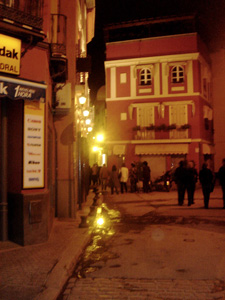Semester at
Sea Fall
2006 Voyage 
Flamenco for Foreigners

Sitting a few rows ahead of me, a
Japanese couple has their
photograph taken together by a young woman charging a few Euros for
this memento. An older couple behind me speaks hurriedly in
Spanish on their cell phones, waiting until the lights of the
performance hall dim before switching them off. A man in the
front looks as though he may be perhaps from India, and has a fashion
similar to the men I observed there. We sat there, Japanese,
Indian, American, Spanish, about to partake in an increasingly evident
transnational performance of the famous flamenco dancers.
In Maria Papapavlou’s article “The
City as
a Stage: Flamenco in Andalusian Culture”, she discusses the tradition
of flamenco dancing and the perception of flamenco heritage amongst
Gitanos and non-Gitanos. Upon attending a flamenco show in
Andalusia, I had a difficult time determining the origin of the
performers, but realized that the show that we were witnessing was
definitely a cultural show tailored to tourism. The dancers were
elaborately dressed, and the band played songs from operas that were
familiar to all members of the audience. As opposed to the
author’s article, in which she discussed the necessary participation
and loud involvement from the audience, the audience reacted to the
show by watching in silence and only clapping at the conclusion of a
performance, as is standard behavior in our social norms.
The city of Sevilla that I visited in
southern Spain was the most familiar city that I had visited on this
voyage. When I stepped out of the train station and took a taxi
cab into the city, I felt as though I was in any city in the United
States. Aside from some landmarks such as the huge cathedral, a
highly European plaza with large fountains, and the city alcazar, the
sights of the city were remarkably similar to most U.S. cities.
There was construction occurring throughout the city in order to
install a subway system, high-end shopping was found throughout the
city’s downtown, and Starbucks were situated at almost every
corner. I found myself sitting in Starbucks, listening to
Christmas music, and enjoying the seasonal gingerbread latte, a
tradition that I do every December at home.
I felt a similarity between my
experiences
in Spain, the last country that we visited on this voyage, and Japan,
the first. These two countries were both so highly westernized,
so completely modern that one could feel completely at home walking
down the street, and if not for the interspersed images of the
vernacular, the temples of Japan or the cathedrals of Spain, it is easy
to feel as though one is still in the States. Following in the
examples as I have seen in many other countries that we have visited
throughout the world, the cultural flamenco show was even geared
towards tourists and presented in a way that is familiar and
appreciated by audiences from all over the world.